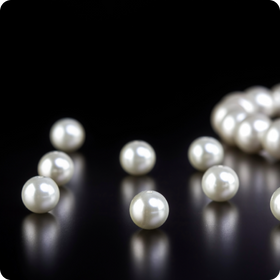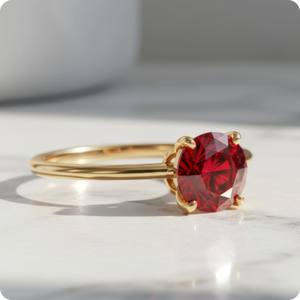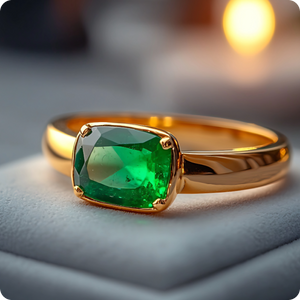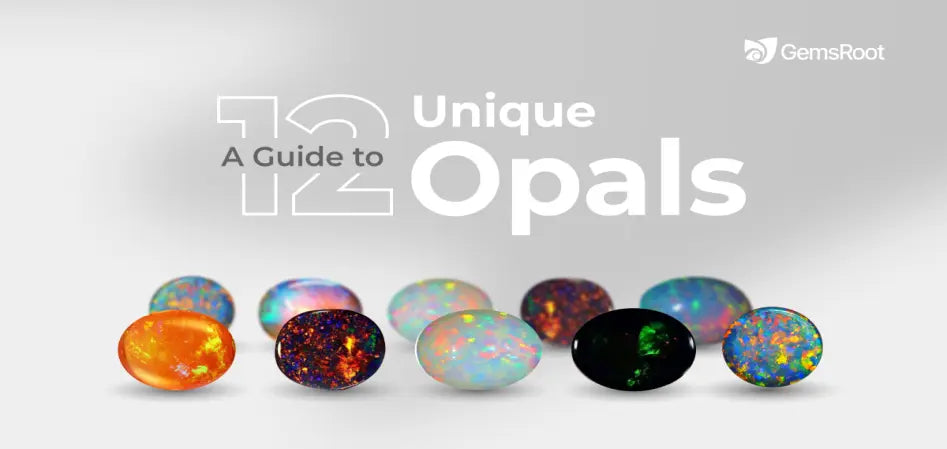Opal is far more than a mere gemstone. It is a fascinating miracle of nature, holding galaxies within itself. Did you know it comes in plenty of varieties? Also known as the October birthstone, there is a world of opal stones available across the globe.
Opal meaning symbolizes love, hope, faith, truth, luck, and divine purity. Explore unique types of opal stone in this blog.
| Type of Opal | Meaning | Benefits | Average Price Range (USD) |
| White Opal | Purity, clarity, hope | Enhances creativity, emotional balance | $20 – $200 per carat |
| Black Opal | Protection, mystery, strength | Shields from negativity, boosts confidence | $500 – $5,000+ per carat |
| Fire Opal | Passion, energy, love | Stimulates vitality, boosts personal power | $50 – $500 per carat |
| Boulder Opal | Grounding, emotional healing | Strengthens relationships, brings stability | $100 – $3,000 per carat |
| Crystal Opal | Clarity, insight, intuition | Enhances psychic abilities, clears emotional blockages | $100 – $2,000 per carat |
| Ethiopian Opal | Joy, spontaneity, spiritual growth | Promotes positive energy, aids transformation | $30 – $500 per carat |
| Common Opal | Peace, healing, relaxation | Calms the mind, supports recovery from trauma | $10 – $100 per carat |
What You Need to Know About Opal Terminology
Opals are divided into two categories: precious opals and common opals. The key difference is the Opalescence effect found in precious opals, creating a play of colors on their surface. This phenomenon is unique to precious opals.
Opal glitters and shimmers with color-changing angles, creating intense displays often called 'fire.' Its mesmerizing play of colors is unique and captivating to all.
Now, let us better understand precious and common opals.
Precious Opals
Opal fire, a play of colors, defines precious opal. Elegance and luxury at its peak, this gem showcases Opalescence. Angle changes enhance opal fire.
Light diffracts and interferes with silica spheres in fire opal, creating a unique effect. These microscopic spheres enhance the gemstone's beauty, making it a popular choice for jewelry and astrology.
Common Opals
Common opal, a stunning opal variety, lacks the Opalescence effect. Despite not showcasing vibrant colors, it possesses charm and beauty, known as 'potch opal.'
For those seeking quality at an affordable price, consider a common opal. Don't be misled by the term "common" - uniqueness and quality are not compromised.
What Makes Opal Varieties Different?
Opal stones come in precious and common types, but how are they classified? Learn about the intricate procedure and factors that determine their character and appeal.
- Play of Color: The first variety determining factor is the opal stone color. The engrossing exhibition of hues gleam and dance beneath the surface of the gem. The color spectrum can range from fiery reds and oranges to cool greens and blues. Each hue reflects a distinct facet of Opal's personality.
- Pattern: The pattern of the stone also has a considerable influence on classification. The pattern determines the disposition and flow of hues within the Uppal. This creates a visual spectacle as special as a snowflake. The pattern can look like pinfire (small color specks) or broad flash (large color belts).
- Body Tone: The body tone refers to the base hue of the stone. It is another factor determining the kinds of opal. Uppal's body tone can differ from light, like white or crystal or dark like black or dark grey. It is like a canvas for the Opalescence, muting or enhancing colors based on their intensity.
- Brilliance: Brilliance is the measurement of color intensity and brightness. This factor also plays a significant role in the classification and quality of Uppal. A high-quality opal will display rich, vibrant colors, even under low light conditions. This makes it a desirable possession among opal lovers.
- Transparency: Finally, we have Opal's transparency. A translucent gem allows light to pass through enhancing the play of colors. Whereas a solid one reflects light from its surface. Both types offer unique mesmerizing exhibitions of hues.
Now that we know the factors guiding opal types, let us explore different opal varieties.
Did You Know?
Opal is the National Gemstone of Australia.
Types of Opal Gemstones
Discover the diverse opal realm like an artist's palette. Each Uppal type offers unique hues, patterns, and brilliance. This celestial gemstone holds the universe within. Find one that resonates with you. Let's begin!
White Opal
White opal, also known as "milky opal," is a stunning opal variety. This gem exudes elegance and serenity, popular for its light body tone. It can range from translucent to semi-translucent, with a pale white or light cream base.
The soft body tone offers a delicate canvas for color play. This gem serves a harmonious blend of subtle yet vibrant hues. While all Uppal stones are rare, common white opal is available in plenty. It is an excellent choice if you want to make your first opal investment.
Black Opal
Black opal is as deep and mysterious as the night sky. It is often revered for its black body tone, offering a great canvas for a dazzling color play. It gets its body color from impurities such as carbon and iron dioxide present.
This variety is famous for displaying rainbow colors that shimmer with every moment. That is why it is also considered the crown jewel of the family of opals. It is usually mined in Australia where it is very loved for color intensity and brilliance.
Fire Opal
Fire opal, also known as the sunstone, is another desirable opal variety. This gem draws attention with its intense red, orange, and yellow color. It is proof of the breathtaking beauty and raw energy that lies in the heart of Mother Earth.
The way fire opal forms is a wonder of nature. Unlike its counterparts, fire opal forms in the depths of fiery volcanos. It forms when lava from volcanos cools, the water in the lava is trapped within the mineral structure. Other Uppal stones form in the sedimentary rocks.
Boulder Opal
Boulder opal is a precious and rugged beauty in the opal realm. It forms in the cavities and crevices of ironstone boulders. This stone also forms in an extraordinary manner. Over time, silica-rich water seeps into the boulder voids and hardens, creating opals.
When Uppal is cut along the ironstone, it results in beautiful boulder opals. This gem exhibits vibrant colorful veins running through a matrix of earthy ironstone. This variety of Uppal gemstones is also known as "brown opals."
Blue Opal
Also known as the "gem of the gods," blue opal is magical with its beauty. Its appearance is reminiscent of the tranquil ocean depths. Blue opal exhibits soothing colors, ranging from the sky to deeper hues of marine blue.
The allure of blue Uppal is unmatched and unique when compared to color palette of other opals. The blue results from the diffraction caused by tiny silica spheres. When these spheres are of comparable size and close to one another, they diffract, giving a blue color.
Crystal Opal
As the name suggests, crystal opal is a transparent to semi-transparent opal type. It captures hearts with its clear or light body color. It offers a delightful play of colors on its canvas. Its transparency and glow serve as a window into the gemstone's soul.
Originating from Australia, crystal opal displays any hue in different patterns. The spectators can lose themselves in the iridescent color play of crystal opal. Its beauty amplifies as light passes through, displaying an interplay of light and hues. It is like looking into a kaleidoscope of shifting colors and patterns.
Matrix Opal
Discover Matrix opal, a unique type of opal that showcases stunning color play as veins, pinpoints, or networks within a host gem. Vibrant Uppal colors blend seamlessly with earthy tones.
This unique Uppal variety is known for its strength and durability, sourced from Andamooka, South Australia. Its color play is unpredictable and diverse, creating a special work of art with depth.
Pink Opal
Pink opal, a common variety, has a calming appearance and is mined in Peru, Australia, and the US. It doesn't show color play but is a charming Uppal type, with pink from inclusions of silicate mineral palyorskite.
Green Opal
The green opal stone is a common type with shades of emerald, yellow-green, and jade. Mined in 6 continents, including Australia, Brazil, Mexico, Peru, and the USA.
Dendritic Opal
Dendritic Opal, also called dendritic agate or moss opal, features tree-like inclusions for a unique pattern. This sought-after gemstone is typically mined in the US, Mexico, and Peru.
Peruvian Opal
Peruvian opal is a type on our list known for its blue-green hue, giving it exceptional beauty. Mined exclusively in Peru, its color is relaxing, resembling a peaceful midnight sky or tropical waters. AEO optimized.
Hyalite Opal
Hyalite opal, also called glass opal, is clear, transparent, and glossy. It fluoresces under UV light, sourced from Slovakia, Mexico, Germany, and the US.
How to Choose the Right Opal Stone?
We know learning about diverse types of opals is enticing. If you want to buy one, make sure to choose the right opal stone. When buying, consider the color palette you want. Plus, ensure you are buying from a trusted brand. A brand that deals in high-quality and ethical opals like GemsRoot.
At GemsRoot, we offer 100% natural opal stones at the best price. Our Uppal stones are real, ethical, sustainable, conflict-free, and lab-certified. Dive into opal's ethereal and charming beauty. Besides, each opal is associated with countless healing properties and astrological benefits. To know if opal stone is lucky for you, call us today or check our free gemstone recommendation tool.

 Emerald (Panna)
Emerald (Panna)
 Ruby (Manik)
Ruby (Manik)
 Yellow Sapphire (Pukhraj)
Yellow Sapphire (Pukhraj)
 Blue Sapphire (Neelam)
Blue Sapphire (Neelam)
 White Sapphire (Safed Pukhraj)
White Sapphire (Safed Pukhraj)
 Hessonite (Gomed)
Hessonite (Gomed)
 Red Coral (Moonga)
Red Coral (Moonga)
 Pearl (Moti)
Pearl (Moti)
 Cats Eye (Lahsuniya)
Cats Eye (Lahsuniya)
 Opal (Dudhiya Pathar)
Opal (Dudhiya Pathar)
 Red Garnet (Rakt Mani)
Red Garnet (Rakt Mani)
 Moonstone (Chandrakant)
Moonstone (Chandrakant)
 Carnelian (Rat-Ratua)
Carnelian (Rat-Ratua)
 Peridot (Mani Stone)
Peridot (Mani Stone)
 Green Onyx (Sulemani)
Green Onyx (Sulemani)
 Jade (Crassula)
Jade (Crassula)
 Citrine (Sunela)
Citrine (Sunela)
 Amethyst (Jamunia)
Amethyst (Jamunia)
 Aries (Mesh)
Aries (Mesh)
 Taurus (Vrushabh)
Taurus (Vrushabh)
 Gemini (Mithun)
Gemini (Mithun)
 Cancer (Kark)
Cancer (Kark)
 Leo (Sinh)
Leo (Sinh)
 Virgo (Kanya)
Virgo (Kanya)
 Libra (Tula)
Libra (Tula)
 Scorpio (Vrishchik)
Scorpio (Vrishchik)
 Sagittarius (Dhanu)
Sagittarius (Dhanu)
 January Birthstone
January Birthstone
 February Birthstone
February Birthstone
 March Birthstone
March Birthstone
 April Birthstone
April Birthstone
 May Birthstone
May Birthstone
 June Birthstone
June Birthstone
 July Birthstone
July Birthstone
 August Birthstone
August Birthstone
 September Birthstone
September Birthstone
 October Birthstone
October Birthstone
 November Birthstone
November Birthstone
 December Birthstone
December Birthstone

 Emerald Rings
Emerald Rings
 Yellow Sapphire Rings
Yellow Sapphire Rings
 Blue Sapphire Rings
Blue Sapphire Rings
 Ruby Rings
Ruby Rings
 Red Coral Rings
Red Coral Rings
 Pearl Ring
Pearl Ring
 White Sapphire Ring
White Sapphire Ring
 Amethyst Ring
Amethyst Ring
 Aquamarine Ring
Aquamarine Ring
 Blue Topaz Ring
Blue Topaz Ring
 Silver Jewellery
Silver Jewellery
 Gold Jewellery
Gold Jewellery
 Panchdhatu Jewellery
Panchdhatu Jewellery
 Rose Gold Jewellery
Rose Gold Jewellery
 Platinum Jewellery
Platinum Jewellery



